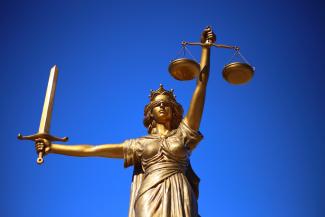Note: This article discusses sexual violence.
The end of the U.S. Supreme Court’s 2021-22 session concluded with devastating, but not unexpected, blows to human rights. The end of January 2023 would have been the 50th anniversary of Roe v. Wade, but it was not. In light of this missed anniversary, we’d like to revisit two cases with far-reaching implications that undermine the safety and freedom of individuals under American law, as well as the reputation of the Court.
These cases include Dobbs v. Jackson Women’s Health Organization, which declared that abortion is not a constitutional right. This case overturned the long-standing precedent set by Roe v. Wade and Planned Parenthood v. Casey, leaving abortion rights to be determined by individual states. Only one week later, the Court released its decision in West Virginia v. Environmental Protection Agency, limiting EPA’s authority to regulate greenhouse gases from power plants under CAA §111(d) based on its finding that the “major questions” doctrine applied.
The Court’s decisions in Dobbs and West Virginia fail to account for the intersectionality of the issues on which they are deciding, with devastating results that will continue unfolding for many years.
At first glance, Dobbs and West Virginia appear to be substantively unrelated. After all, reproductive justice—the right of an individual to bodily autonomy over reproductive choices—is often discussed as an entirely distinct area of law, policy, and rights from environmental justice—the fair treatment and meaningful involvement of all people with respect to the development, implementation, and enforcement of environmental laws and policies.
However, using an intersectional lens, reproductive justice is environmental justice. The two are intrinsically linked by a myriad of issues related to health, safety, and equality. Dobbs and West Virginia together disproportionately deny women and other gender-minority identities their constitutional rights to equality, freedom, protection, and life. These cases released in tande

m compound the negative impacts each will have separately. Such impacts will further exacerbate environmental and reproductive injustices as climate change progresses.
Climate change is a threat multiplier that risks exacerbating existing societal inequities. In our violently patriarchal society, this means that women, girls, trans people, and non-binary and gender-nonconforming people, who are already particularly vulnerable to human rights violations, are made even more so by climate change. Climate change and its harms fall disproportionately on women, girls, trans, and non-binary and gender-nonconforming people in low-income communities and communities of color due to a systematic lack of access to economic and healthcare resources, a product of historical and current racism and classism in the United States.
There are two primary concerns at the intersection of climate change and reproductive rights resulting from the Dobbs and West Virginia decisions. First, climate change increases the likelihood of becoming pregnant against one's will, as rising global temperatures is associated with an increase in unwanted and unplanned pregnancies resulting from sexual violence.
As the planet warms, extreme weather and climate disasters have been found to increase gender-based violence, including sexual violence, which can result in more unplanned and unwanted pregnancies.
Natural disasters are associated with increased instances of domestic violence in the short and long term. Disaster itself can trigger an increase in the severity of existing violence, while disrupted public safety and transportation infrastructure simultaneously limits a person's ability to escape an abusive partner or call for help.
Furthermore, climate change-related natural disasters are already causing displacement and forced migration, including in the United States, putting women in a situation in which they are more at risk of trafficking than men. Forced migration leads to a host of concerns, some of which are tied to insecure housing and shelter. Thirty-one percent of sexual violence that was reported in the aftermath of Hurricanes Katrina and Rita took place in evacuation shelters.
Second, climate change can also make pregnancy more dangerous and lead to negative health outcomes.
Emergency settings often complicate access to sexual and reproductive health services, potentially making abortions more commonly needed (if contraception is harder to obtain) and more difficult to safely obtain. Flooding, drought, forest fires, and other climate-change perturbations enhance risk of food scarcity, putting pregnant and breastfeeding people at greater risk of malnutrition. Survivors of climate-related natural disasters are more likely to be exposed to air pollution or other toxins associated with pre-term and low-weight births.
Previous literature has shown that extreme crisis events are correlated with child marriages becoming more common, making abortion access all the more critical. Pregnancy before the age of 15 is dangerous for the pregnant person, increasing the likelihood of serious harm or death.
To summarize: the 2021-2022 SCOTUS session was destructive for a number of reasons. The West Virginia decision limited the federal government’s ability to mitigate more frequent and destructive natural disasters that—among many other harms—increase the likelihood of unplanned, unwanted, and dangerous pregnancies. Simultaneously, in Dobbs, the Court erased a pregnant person’s federal right to end pregnancies. As a result, the women, girls, trans, and non-binary and gender-nonconforming people living in states without codified abortion rights—many of which are the states most affected by climate-related natural disasters in the United States—will be most adversely impacted.
People deserve to feel safe in their bodies, in their homes, in their communities, and on the planet regardless of their gender identity, race, class, and disability status, among others.


